初三英语教学案例分析【最新】
英语教学案例分析 (菁选最新4篇

英语教学案例分析(菁选最新4篇英语教学案例分析篇一1、Task-Based Language Teaching,即TBLT这是新课标之后实行的新型教学方法——任务型教学,这个意识半会儿说不清楚,你得好好研究一下。
如果成功了,这个教学方法课堂效果会很好。
2、五步教学法:Step 1 Warming upStep 2 Presentation and practiceStep 3 PresentationStep 4 PracticeStep 5 Post Task3、五指教学法:RPCPPStep 1 ReviewStep 2 PresentationStep 3 ConsolidationStep 4 PracticeStep 5 ProjectPresentation4.3P教学法Warming-upPresentationPracticeProductionHomework5交际型教学Communicative Teaching在教学过程中创设或模拟真实情景交际,让学生通过听、说、理解等交际活动不断沟通交流、进行互动的一种教学模式下面谈一谈英语学习方式前面提到四种学习方式:合作学习/共同学习、自主学习、任务型学习、探究学习。
下面就对它们做一个简明扼要的介绍。
这个介绍是提纲挈领的介绍,涉及不到十分具体的技巧。
关于技巧方面可以在培训班另安排时间深入探讨。
过去(甚至目前)学生课堂学习的方式比较单一、枯燥乏味、效果不佳。
这种学习方式就是大家所熟悉的学生听教师讲为主的方式。
《英语课程标准》建议教师帮助学生掌握多种学习方式。
这里介绍的四种学习方式,不是全部的学习方式,比如,有条件的地方,可以利用多媒体手段、利用互联网络进行学习。
这里介绍四种学习方式,不意味着其他学习方式不好,或者无效,而是要根据教学实际情况选择使用、交替使用、综合使用。
而且,教师讲解也不是在教学中没有任何地位,必要的时候,仍然可以使用。
初三英语教育教学案例(2篇)
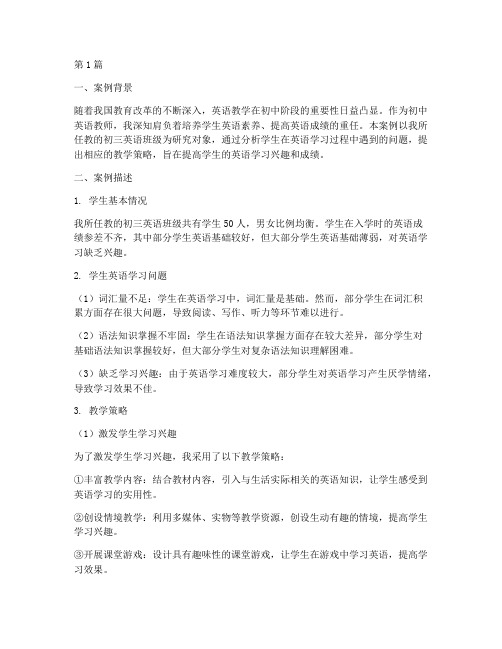
第1篇一、案例背景随着我国教育改革的不断深入,英语教学在初中阶段的重要性日益凸显。
作为初中英语教师,我深知肩负着培养学生英语素养、提高英语成绩的重任。
本案例以我所任教的初三英语班级为研究对象,通过分析学生在英语学习过程中遇到的问题,提出相应的教学策略,旨在提高学生的英语学习兴趣和成绩。
二、案例描述1. 学生基本情况我所任教的初三英语班级共有学生50人,男女比例均衡。
学生在入学时的英语成绩参差不齐,其中部分学生英语基础较好,但大部分学生英语基础薄弱,对英语学习缺乏兴趣。
2. 学生英语学习问题(1)词汇量不足:学生在英语学习中,词汇量是基础。
然而,部分学生在词汇积累方面存在很大问题,导致阅读、写作、听力等环节难以进行。
(2)语法知识掌握不牢固:学生在语法知识掌握方面存在较大差异,部分学生对基础语法知识掌握较好,但大部分学生对复杂语法知识理解困难。
(3)缺乏学习兴趣:由于英语学习难度较大,部分学生对英语学习产生厌学情绪,导致学习效果不佳。
3. 教学策略(1)激发学生学习兴趣为了激发学生学习兴趣,我采用了以下教学策略:①丰富教学内容:结合教材内容,引入与生活实际相关的英语知识,让学生感受到英语学习的实用性。
②创设情境教学:利用多媒体、实物等教学资源,创设生动有趣的情境,提高学生学习兴趣。
③开展课堂游戏:设计具有趣味性的课堂游戏,让学生在游戏中学习英语,提高学习效果。
(2)加强词汇教学针对学生词汇量不足的问题,我采取了以下措施:①词汇分类记忆:将词汇按照主题、词性等进行分类,帮助学生记忆。
②词根词缀法:讲解词根词缀,帮助学生掌握词汇规律,提高词汇记忆效率。
③词组搭配:引导学生学习词组搭配,提高词汇运用能力。
(3)强化语法教学针对学生语法知识掌握不牢固的问题,我采取了以下措施:①结合例句讲解:通过讲解典型例句,帮助学生理解语法知识。
②语法练习:设计具有针对性的语法练习,让学生在练习中巩固语法知识。
③语法竞赛:举办语法竞赛,激发学生学习兴趣,提高语法水平。
英语人教版九年级全册教学案例分析

由点到面掌握语法培养创新——人教版 Go for it九年级Unit 6 Self-check复习课教学案例分析周洁茶恩寺镇大花桥中学由点到面掌握语法培养创新——人教版 Go for it九年级Unit 6 Self-check复习课教学案例分析(1)主题阐述:新目标初中英语教材融汇话题、交际功能和语言结构,采用任务型语言教学模式,自有一套由易到难循序渐进的与生活息息相关的学习程序。
这套教材编排有很多优点,然而由于学生认知水平的发展具有局限性和规律性,教师只有在充分了解吃透教材的情况下,掌握学生的认知规律,充分发挥学生的主体作用,教学相长,才能在实际教学中取得最优化的教学效果。
(2)教学设计意图:本课时为复习课程,容量大,密度高,节奏快,要面面俱到而重点突出,充分锻炼学生英语学习的听说读写能力。
本节课意图通过先对本课进行从词及句的复习,再设计多样化教学活动,充分调动学生的积极性,打开学生思维,培养学生的创新意识,鼓励学生进行发明创造。
(3)课堂写真:1 Warm up1)Greet the Ss and divide them into three groups. Introduce the competing system.设计意图:本节课内容多,强度大,提前确立竞争机制,可以提高学生复习的效率,同时带动课堂积极性。
2 Review the phrases1)Present a picture on the PPT, remind Ss it’s “change the world”. Read it for two times.设计意图:从简入难,带领学生迅速进入学习状态。
2)Speed competition. Ss from groups should stand up and say the phrases, and the first one will win his or her group a mark.设计意图:复习本单元所学重点词组,带过单词,竞争机制提高学生参与度和复习的速度。
英语教学案例分析范文6篇初中

英语教学案例分析范文6篇初中Effective English teaching in middle school is crucial for laying a strong foundation for students' language proficiency and future academic success. In this essay, we will examine six case studies that illustrate various approaches and strategies employed by skilled English teachers to engage and support their middle school students.Case Study 1: Integrating Technology to Enhance Engagement Mrs. Johnson, an experienced English teacher at a suburban middle school, recognized the importance of incorporating technology to captivate her students' attention and foster active learning. She began by introducing interactive whiteboard activities, where students could manipulate words, sentences, and grammatical structures on the board, enhancing their understanding of language concepts. Additionally, Mrs. Johnson utilized online educational platforms that provided personalized practice exercises and immediate feedback, allowing students to take ownership of their learning and progress at their own pace.The integration of technology not only increased studentengagement but also enabled Mrs. Johnson to differentiate instruction and cater to diverse learning styles. Students who struggled with traditional pen-and-paper exercises found the digital activities more appealing and accessible, while those who thrived on independent learning benefited from the self-paced nature of the online resources. The result was a more dynamic and inclusive classroom environment, where all students felt empowered to participate and succeed in their English studies.Case Study 2: Fostering Critical Thinking through Literature Circles Mr. Patel, a middle school English teacher in a diverse urban setting, recognized the importance of developing his students' critical thinking skills. He implemented a literature circles approach, where students were divided into small groups and assigned different roles, such as discussion leader, connector, and literary analyst. Each group was responsible for reading a selected work of literature and engaging in collaborative discussions to unpack the themes, characters, and literary devices.The literature circles not only encouraged active engagement with the text but also cultivated essential communication and problem-solving skills. Students learned to listen actively, express their ideas clearly, and consider multiple perspectives. Mr. Patel's role shifted from a traditional lecturer to a facilitator, guiding the discussions and prompting students to delve deeper into the literary analysis.The success of this approach was evident in the students' increased confidence in expressing their interpretations and the depth of their literary analysis. Additionally, the collaborative nature of the literature circles fostered a sense of community and camaraderie among the students, further enhancing their overall learning experience.Case Study 3: Integrating Authentic Cultural ExperiencesIn a middle school with a growing population of English language learners, Ms. Garcia recognized the importance of incorporating authentic cultural experiences into her English lessons. She collaborated with the school's diversity committee to organize cultural celebrations and invite guest speakers from various backgrounds to share their stories and traditions.During these events, students had the opportunity to engage with the English language in a meaningful and contextual manner. They learned vocabulary and expressions related to the featured cultures, participated in interactive activities, and gained a deeper appreciation for the diversity within their school community. The cultural experiences also served as a platform for students to practice their speaking and listening skills in a low-stress, authentic setting.The integration of authentic cultural experiences not only improvedthe English language proficiency of the English language learners but also fostered a greater sense of inclusion and understanding among all students. The cross-cultural exchange and exposure to diverse perspectives enriched the learning environment and contributed to the overall growth and development of the students.Case Study 4: Differentiated Instruction for Struggling Readers Mrs. Nguyen, a middle school English teacher in a high-needs district, recognized the diverse learning needs of her students, particularly those who struggled with reading comprehension. She implemented a multi-tiered system of support, where she provided targeted interventions and differentiated instruction to address the individual needs of her students.For students who required additional support, Mrs. Nguyen utilized research-based reading strategies, such as guided reading, vocabulary development, and explicit instruction in phonics and fluency. She also incorporated the use of audiobooks, text-to-speech software, and graphic organizers to help struggling readers access the content and actively engage with the material.Mrs. Nguyen's dedication to differentiated instruction paid off, as her struggling readers demonstrated significant improvements in their reading abilities and overall academic performance. The individualized attention and tailored support not only boosted theirconfidence but also instilled a love for reading and learning.Case Study 5: Integrating Project-Based LearningMr. Goldstein, a middle school English teacher in a suburban setting, recognized the importance of making the English curriculum more relevant and engaging for his students. He implemented a project-based learning approach, where students were tasked with creating multimedia presentations on topics of their choice, ranging from social issues to literary analyses.The project-based learning approach allowed students to take an active role in their learning, as they conducted research, synthesized information, and utilized various technological tools to present their findings. Mr. Goldstein provided guidance and feedback throughout the process, ensuring that students developed essential skills, such as critical thinking, problem-solving, and effective communication.The project-based learning activities not only enhanced the students' engagement and motivation but also fostered their ability to collaborate, think creatively, and apply their knowledge to real-world situations. The final presentations showcased the students' diverse talents and perspectives, further enriching the learning environment.Case Study 6: Integrating Interdisciplinary ConnectionsMs. Lim, a middle school English teacher in a STEM-focused school,recognized the importance of integrating interdisciplinary connections to make the English curriculum more relevant and meaningful for her students. She collaborated with her colleagues from the science, mathematics, and social studies departments to develop cross-curricular lessons and projects.For example, in a unit on persuasive writing, Ms. Lim worked with the science teacher to have students research and write persuasive essays on environmental issues. The students not only honed their English language skills but also deepened their understanding of scientific concepts and their real-world applications. Similarly, in a poetry unit, Ms. Lim partnered with the art teacher to have students create visual representations of their poems, fostering their creativity and artistic expression.The integration of interdisciplinary connections not only enhanced the relevance and depth of the English curriculum but also encouraged students to see the interconnectedness of different subject areas. This approach helped students develop a more holistic understanding of the world around them and the role of language in various disciplines.In conclusion, the six case studies presented in this essay demonstrate the diverse and effective strategies employed by skilled English teachers in middle school settings. From integratingtechnology to fostering critical thinking, incorporating authentic cultural experiences, differentiating instruction, implementing project-based learning, and making interdisciplinary connections, these teachers have created dynamic and inclusive learning environments that support the academic and personal growth of their students. The success of these approaches underscores the importance of continuous professional development, collaboration, and a student-centered approach to English language instruction in middle schools.。
英语人教版九年级全册教学案例分析
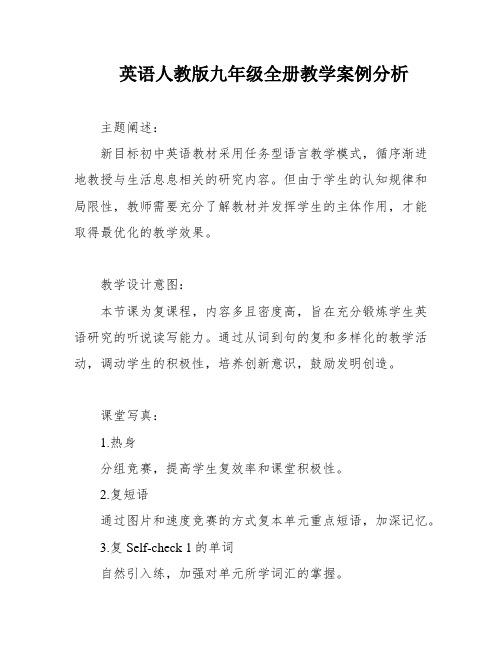
英语人教版九年级全册教学案例分析主题阐述:新目标初中英语教材采用任务型语言教学模式,循序渐进地教授与生活息息相关的研究内容。
但由于学生的认知规律和局限性,教师需要充分了解教材并发挥学生的主体作用,才能取得最优化的教学效果。
教学设计意图:本节课为复课程,内容多且密度高,旨在充分锻炼学生英语研究的听说读写能力。
通过从词到句的复和多样化的教学活动,调动学生的积极性,培养创新意识,鼓励发明创造。
课堂写真:1.热身分组竞赛,提高学生复效率和课堂积极性。
2.复短语通过图片和速度竞赛的方式复本单元重点短语,加深记忆。
3.复Self-check 1的单词自然引入练,加强对单元所学词汇的掌握。
设计意图:引导学生通过四个方面来描述一个发明,锻炼他们的描述能力和逻辑思维。
3)Give Ss some time to brainstorm and write their own XXX.4)Ask some volunteers to share their ns and give XXX.设计意图:通过学生的分享和互相反馈,让他们加深对创新和发明的理解,同时提高他们的口语表达和听力能力。
Design Intent: The purpose of this lesson is to encourage students to observe and learn from others' ns。
and to improve their n to new ns and the use of core XXX.Activity 1: Show students a picture of a magical box and ask them to write down their own XXX。
XXX according to the light。
Encourage group n and have students put their ideas in the boxwith their names on them.Activity 2: XXX from the box and asks students to XXX will then present their own XXX class.Activity 3: Students will be asked to make sentences using a given structure to describe an item in an organized manner.Activity 4: Each group will be given three ns with details and asked to write about one XXX' use of sentence structures.Summary: The lesson will end with a summary of what was learned and the announcement of the winning group。
初中英语教研案例分析(3篇)

第1篇一、背景介绍随着新课程改革的深入推进,初中英语教学越来越注重学生的主体地位和课堂互动。
然而,在实际教学中,部分教师仍存在教学方法单一、课堂氛围沉闷、学生参与度低等问题。
为了提高英语教学质量,本案例以某初中英语教研组为研究对象,通过分析课堂互动策略,探讨如何提升学生的参与度。
二、案例描述某初中英语教研组在近期开展了以“基于课堂互动提升学生参与度”为主题的教研活动。
活动主要分为以下几个阶段:1. 前期调研:教研组对所任教的班级进行问卷调查,了解学生对英语课堂的满意度、参与度以及存在的问题。
2. 问题分析:根据调查结果,教研组发现以下问题:- 部分学生英语基础薄弱,自信心不足;- 教师教学方法单一,缺乏趣味性;- 课堂氛围沉闷,学生参与度低。
3. 策略研究:针对以上问题,教研组提出了以下策略:- 丰富教学方法:运用多种教学手段,如多媒体、游戏、小组合作等,激发学生的学习兴趣;- 创设情境:结合生活实际,创设真实、生动的语言环境,提高学生的语言运用能力;- 关注个体差异:针对不同学生的学习基础,设计分层教学,满足不同学生的学习需求;- 加强课堂互动:鼓励学生积极参与课堂活动,提高学生的语言表达能力和合作意识。
4. 实践应用:教研组将以上策略应用于实际教学中,并进行了以下尝试:- 小组合作学习:将学生分成若干小组,进行角色扮演、讨论等活动,提高学生的合作能力和语言表达能力;- 游戏教学:设计趣味性强的英语游戏,让学生在游戏中学习英语,提高学习兴趣;- 情境教学:结合教材内容,创设真实、生动的情境,让学生在情境中运用英语;- 课堂提问:采用多种提问方式,激发学生的思考,提高学生的参与度。
5. 效果评估:经过一段时间的实践,教研组对学生的英语学习情况进行了跟踪调查,发现以下变化:- 学生的英语成绩有所提高;- 学生对英语课堂的满意度明显提升;- 学生的参与度明显提高,课堂氛围活跃。
三、案例分析本案例通过分析课堂互动策略,探讨了如何提升学生的参与度。
初三英语教育案例(3篇)

第1篇一、案例背景我国教育改革不断深化,初中英语教育作为基础教育的重要组成部分,其教学质量直接影响着学生的英语素养。
初三英语教学是整个初中阶段的关键时期,学生正处于青春期,学习兴趣、学习习惯和学习方法等方面存在较大差异。
本文以某中学初三英语教学为例,探讨如何提高初三英语教学质量。
二、案例描述1. 学生情况该班级共有50名学生,其中男生28人,女生22人。
学生成绩分布不均,部分学生对英语学习有浓厚兴趣,成绩较好;而部分学生对英语学习缺乏兴趣,成绩较差。
此外,学生英语学习习惯、学习方法等方面也存在差异。
2. 教学目标(1)提高学生对英语学习的兴趣,激发学习动力;(2)培养学生良好的英语学习习惯;(3)提高学生的英语听说读写能力;(4)帮助学生顺利通过中考。
3. 教学策略(1)激发学习兴趣针对学生对英语学习兴趣不高的现状,教师采用以下策略:①利用多媒体技术,将英语教学与实际生活相结合,提高课堂趣味性;②组织英语角、英语演讲比赛等活动,让学生在轻松愉快的氛围中学习英语;③鼓励学生展示自己的英语才华,增强自信心。
(2)培养学生良好的英语学习习惯①引导学生制定学习计划,合理安排学习时间;②培养学生的自主学习能力,鼓励学生在课后进行英语阅读、听力训练;③关注学生心理变化,及时调整教学方法,帮助学生克服学习困难。
(3)提高学生的英语听说读写能力①加强词汇教学,让学生掌握一定数量的英语词汇;②注重语法教学,提高学生的英语语法水平;③开展英语口语训练,提高学生的英语口语表达能力;④组织英语写作训练,提高学生的英语写作能力。
(4)帮助学生顺利通过中考①分析历年中考英语试题,把握中考英语考试趋势;②针对中考英语题型,开展专项训练;③关注学生的心理状态,减轻学生考试压力。
4. 教学效果经过一段时间的教学实践,该班级学生在英语学习方面取得了以下成果:(1)学生对英语学习的兴趣明显提高,学习动力增强;(2)学生的英语学习习惯得到改善,自主学习能力得到提高;(3)学生的英语听说读写能力得到全面提升;(4)在中考中,该班级英语平均成绩较去年提高了10分。
九年级英语教育教学案例(2篇)

第1篇一、背景随着我国教育改革的不断深入,英语教育越来越受到重视。
九年级作为初中阶段的最后一年,对于学生的英语学习成果有着重要的影响。
在这个阶段,学生已经具备了一定的英语基础,但同时也面临着中考的压力。
因此,如何提高九年级英语教学质量,激发学生的学习兴趣,帮助他们顺利过渡到高中英语学习,成为教师面临的重要课题。
二、案例描述1. 学生情况分析案例中的班级共有学生40人,其中男生20人,女生20人。
大部分学生对英语学习有一定兴趣,但学习效果参差不齐。
部分学生对英语学习存在焦虑情绪,担心中考成绩不理想。
同时,学生的英语学习习惯和自主学习能力有待提高。
2. 教学目标(1)提高学生的英语听说读写能力,使他们在中考中取得优异成绩。
(2)激发学生的学习兴趣,培养学生良好的英语学习习惯。
(3)提高学生的自主学习能力,为高中英语学习打下坚实基础。
3. 教学策略(1)采用多元化的教学方法,激发学生学习兴趣。
(2)注重学生个体差异,实施分层教学。
(3)加强家校合作,共同关注学生的英语学习。
4. 教学实施(1)激发学生学习兴趣为了激发学生的学习兴趣,教师采用了以下教学方法:- 情境教学法:通过创设真实情境,让学生在情境中学习英语。
例如,在教授“Travel”单元时,教师带领学生参观学校附近的景点,让学生用英语介绍景点。
- 游戏教学法:通过设计有趣的游戏,让学生在游戏中学习英语。
例如,在复习词汇时,教师组织“单词接龙”游戏,让学生在游戏中巩固词汇。
- 多媒体教学法:利用多媒体资源,丰富教学内容,提高教学效果。
例如,在教授“Festival”单元时,教师播放有关节日习俗的英文视频,让学生了解不同国家的节日文化。
(2)注重学生个体差异,实施分层教学针对学生个体差异,教师将学生分为三个层次:- A层:英语基础较好,学习能力强。
- B层:英语基础一般,学习有一定难度。
- C层:英语基础较弱,学习困难。
针对不同层次的学生,教师采取了以下措施:- A层:布置难度较高的作业,鼓励学生参加英语竞赛。
初中英语教学案例分析100例
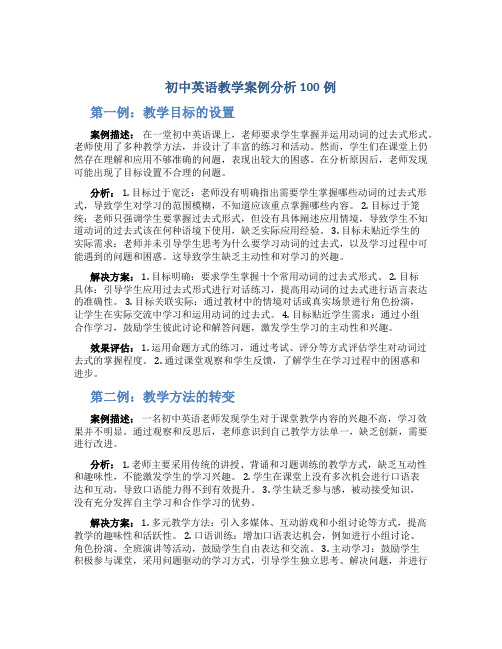
初中英语教学案例分析100例第一例:教学目标的设置案例描述:在一堂初中英语课上,老师要求学生掌握并运用动词的过去式形式。
老师使用了多种教学方法,并设计了丰富的练习和活动。
然而,学生们在课堂上仍然存在理解和应用不够准确的问题,表现出较大的困惑。
在分析原因后,老师发现可能出现了目标设置不合理的问题。
分析: 1. 目标过于宽泛:老师没有明确指出需要学生掌握哪些动词的过去式形式,导致学生对学习的范围模糊,不知道应该重点掌握哪些内容。
2. 目标过于笼统:老师只强调学生要掌握过去式形式,但没有具体阐述应用情境,导致学生不知道动词的过去式该在何种语境下使用,缺乏实际应用经验。
3. 目标未贴近学生的实际需求:老师并未引导学生思考为什么要学习动词的过去式,以及学习过程中可能遇到的问题和困惑。
这导致学生缺乏主动性和对学习的兴趣。
解决方案: 1. 目标明确:要求学生掌握十个常用动词的过去式形式。
2. 目标具体:引导学生应用过去式形式进行对话练习,提高用动词的过去式进行语言表达的准确性。
3. 目标关联实际:通过教材中的情境对话或真实场景进行角色扮演,让学生在实际交流中学习和运用动词的过去式。
4. 目标贴近学生需求:通过小组合作学习,鼓励学生彼此讨论和解答问题,激发学生学习的主动性和兴趣。
效果评估: 1. 运用命题方式的练习,通过考试、评分等方式评估学生对动词过去式的掌握程度。
2. 通过课堂观察和学生反馈,了解学生在学习过程中的困惑和进步。
第二例:教学方法的转变案例描述:一名初中英语老师发现学生对于课堂教学内容的兴趣不高,学习效果并不明显。
通过观察和反思后,老师意识到自己教学方法单一,缺乏创新,需要进行改进。
分析: 1. 老师主要采用传统的讲授、背诵和习题训练的教学方式,缺乏互动性和趣味性,不能激发学生的学习兴趣。
2. 学生在课堂上没有多次机会进行口语表达和互动,导致口语能力得不到有效提升。
3. 学生缺乏参与感,被动接受知识,没有充分发挥自主学习和合作学习的优势。
初中英语教学案例分析(合集5篇)

初中英语教学案例分析(合集5篇)第一篇:初中英语教学案例分析初中英语教学案例分析飞鹅中学林建红教学背景:这个单元主要教学一些物品的名称,如:学习用品,服装,水果,家具等等。
要求学生能用下列句型进行交流。
A: What’s this in English?B: It’s a pen.A: Spell it, please.B:P_E_N,pen.本单元安排在26个字母之后,因此,字母的认读,单词的拼写,以及单词的读音也是本课的重点之一。
在课堂设计的过程中,考虑到这节课的具体情况:单词较少,绝大多数学生都已在小学学过,但是,由于我所教班级学生的英语水平比较薄弱,虽然他们在小学已经学过这部分内容,加上小学英语的要求和初中英语要求的不同,他们对知识点的掌握程度还达不到初中水平。
鉴于以上种种原因,我尝试着用让学生自己教会自己的方法来完成这节课的教学。
整节课,我设计了绘画比赛,问答学习,调查统计等几个环节,一环紧扣一环,让学生在潜移默化中自然而然地学到了新知识。
实践证明,我这样的安排不仅调动了已会的同学,让他们尝到了为人师的成就感和自豪感;与此同时,还让那些不会的同学有了更多更细心的学习机会,排除了师生之间的隔阂,让他们从自己的同龄人中学习,他们感到自然,易于接受。
这不失为本课的一大闪光点。
思路设计:整个过程,教师不是在“教教材”,而是在“用教材教”。
教师根据学生的实际情况和生活经验创造性地使用教材,从学生熟悉的知识入手,创建一个个与学生生活密切相关的问题情景,让学生带着问题思考,寻找解决问题的办法。
真正体现了《新课标》的精神----“在发展语言能力的同时,发展思维能力,激发想象力和创造力。
”活动不应该仅限于课堂教学,而要延伸到课堂之外的学习和生活之中。
同学们回忆自己的不文明行为,作自我批评,是活动的高潮,是自我教育,提高环保意识的最有效手段。
当时,教师应该趁热打铁,利用同学们的这份热情,让同学们利用课余时间,用英语采访同年级的别班同学,让同学们在同龄人面前很自然地回忆自己的不文明行为。
初中英语教学案例分析报告范文6篇
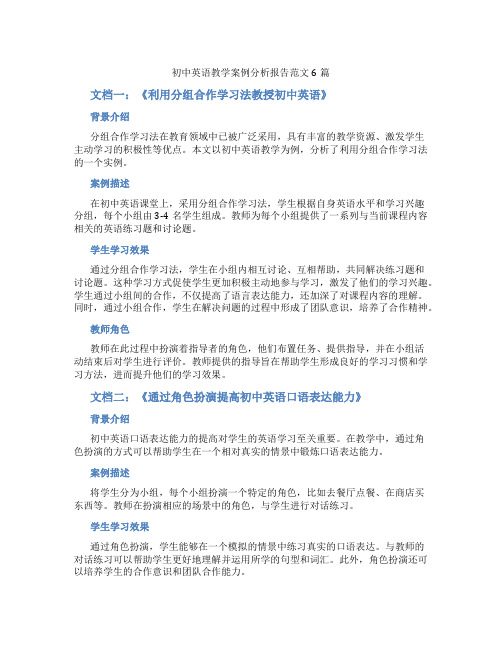
初中英语教学案例分析报告范文6篇文档一:《利用分组合作学习法教授初中英语》背景介绍分组合作学习法在教育领域中已被广泛采用,具有丰富的教学资源、激发学生主动学习的积极性等优点。
本文以初中英语教学为例,分析了利用分组合作学习法的一个实例。
案例描述在初中英语课堂上,采用分组合作学习法,学生根据自身英语水平和学习兴趣分组,每个小组由3-4名学生组成。
教师为每个小组提供了一系列与当前课程内容相关的英语练习题和讨论题。
学生学习效果通过分组合作学习法,学生在小组内相互讨论、互相帮助,共同解决练习题和讨论题。
这种学习方式促使学生更加积极主动地参与学习,激发了他们的学习兴趣。
学生通过小组间的合作,不仅提高了语言表达能力,还加深了对课程内容的理解。
同时,通过小组合作,学生在解决问题的过程中形成了团队意识,培养了合作精神。
教师角色教师在此过程中扮演着指导者的角色,他们布置任务、提供指导,并在小组活动结束后对学生进行评价。
教师提供的指导旨在帮助学生形成良好的学习习惯和学习方法,进而提升他们的学习效果。
文档二:《通过角色扮演提高初中英语口语表达能力》背景介绍初中英语口语表达能力的提高对学生的英语学习至关重要。
在教学中,通过角色扮演的方式可以帮助学生在一个相对真实的情景中锻炼口语表达能力。
案例描述将学生分为小组,每个小组扮演一个特定的角色,比如去餐厅点餐、在商店买东西等。
教师在扮演相应的场景中的角色,与学生进行对话练习。
学生学习效果通过角色扮演,学生能够在一个模拟的情景中练习真实的口语表达。
与教师的对话练习可以帮助学生更好地理解并运用所学的句型和词汇。
此外,角色扮演还可以培养学生的合作意识和团队合作能力。
教师在角色扮演中既是引导者,也是参与者。
他们需要起到积极引导学生参与角色扮演的作用,并及时给予学生反馈和指导。
教师还可以在角色扮演活动结束后进行整体的总结和评价。
文档三:《利用多媒体教具提高初中英语听力能力》背景介绍初中英语听力是学生英语学习中的重要环节。
英语教学案例分析范文(精选27篇)
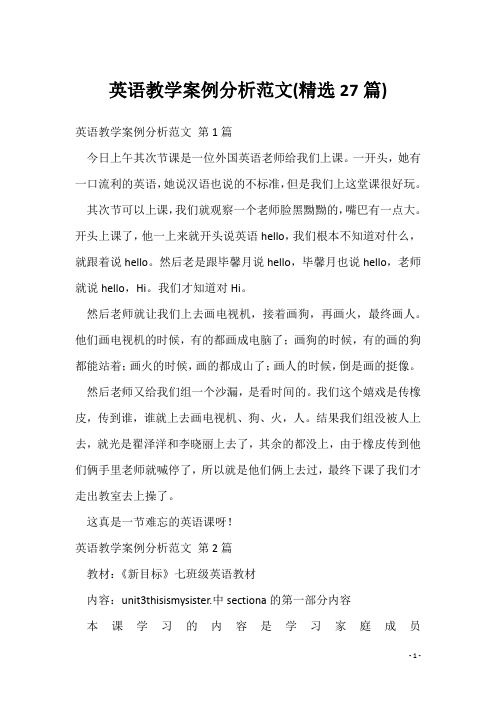
英语教学案例分析范文(精选27篇)英语教学案例分析范文第1篇今日上午其次节课是一位外国英语老师给我们上课。
一开头,她有一口流利的英语,她说汉语也说的不标准,但是我们上这堂课很好玩。
其次节可以上课,我们就观察一个老师脸黑黝黝的,嘴巴有一点大。
开头上课了,他一上来就开头说英语hello,我们根本不知道对什么,就跟着说hello。
然后老是跟毕馨月说hello,毕馨月也说hello,老师就说hello,Hi。
我们才知道对Hi。
然后老师就让我们上去画电视机,接着画狗,再画火,最终画人。
他们画电视机的时候,有的都画成电脑了;画狗的时候,有的画的狗都能站着;画火的时候,画的都成山了;画人的时候,倒是画的挺像。
然后老师又给我们组一个沙漏,是看时间的。
我们这个嬉戏是传橡皮,传到谁,谁就上去画电视机、狗、火,人。
结果我们组没被人上去,就光是翟泽洋和李晓丽上去了,其余的都没上,由于橡皮传到他们俩手里老师就喊停了,所以就是他们俩上去过,最终下课了我们才走出教室去上操了。
这真是一节难忘的英语课呀!英语教学案例分析范文第2篇教材:《新目标》七班级英语教材内容:unit3thisismysister.中sectiona的第一部分内容本课学习的内容是学习家庭成员(father,mother,parent,grandfather,grandmother,grandparent等)并学会向他人介绍自己的家庭成员(.),情境刺激-英语教学案例分析。
由于同学学校学习过家庭成员的英文单词,所以笔者把重点用于教同学如何介绍自己的家庭成员,这一部分也正是同学感爱好的话题。
英语教学案例分析范文第3篇一、前言:在实施新《课程标准》进展素养教育的今日,体育课堂教学不再是传统单调、枯燥的学习氛围,而是要通过教学让同学充分展现、体现自我。
充分体现一个中心、四个特点。
以让同学自动学习,乐观实践,努力创新为中心,结合体育学科突出四个特点。
特殊是对学校低班级同学来说,通过唱游形式进行体育教学,达到教学目的,提高学习成果,激发学习爱好,已逐步成为体育老师一种行之有效的教学**。
初中英语教学案例分析(精选10篇)
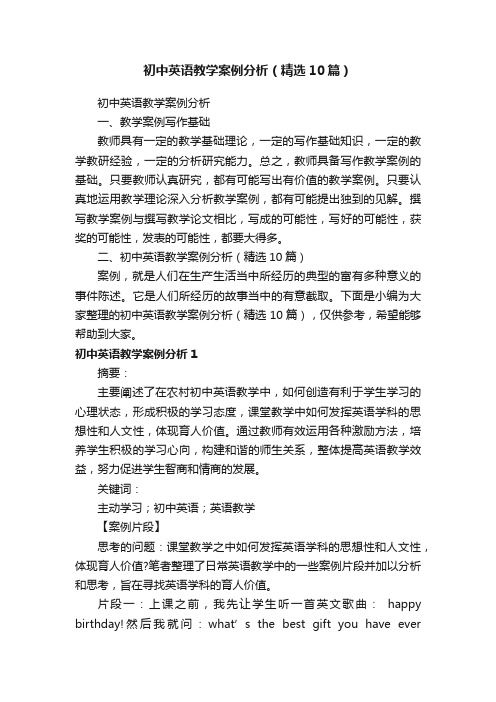
初中英语教学案例分析(精选10篇)初中英语教学案例分析一、教学案例写作基础教师具有一定的教学基础理论,一定的写作基础知识,一定的教学教研经验,一定的分析研究能力。
总之,教师具备写作教学案例的基础。
只要教师认真研究,都有可能写出有价值的教学案例。
只要认真地运用教学理论深入分析教学案例,都有可能提出独到的见解。
撰写教学案例与撰写教学论文相比,写成的可能性,写好的可能性,获奖的可能性,发表的可能性,都要大得多。
二、初中英语教学案例分析(精选10篇)案例,就是人们在生产生活当中所经历的典型的富有多种意义的事件陈述。
它是人们所经历的故事当中的有意截取。
下面是小编为大家整理的初中英语教学案例分析(精选10篇),仅供参考,希望能够帮助到大家。
初中英语教学案例分析1摘要:主要阐述了在农村初中英语教学中,如何创造有利于学生学习的心理状态,形成积极的学习态度,课堂教学中如何发挥英语学科的思想性和人文性,体现育人价值。
通过教师有效运用各种激励方法,培养学生积极的学习心向,构建和谐的师生关系,整体提高英语教学效益,努力促进学生智商和情商的发展。
关键词:主动学习;初中英语;英语教学【案例片段】思考的问题:课堂教学之中如何发挥英语学科的思想性和人文性,体现育人价值?笔者整理了日常英语教学中的一些案例片段并加以分析和思考,旨在寻找英语学科的育人价值。
片段一:上课之前,我先让学生听一首英文歌曲:happy birthday!然后我就问:what’s the best gift you have everreceived?when did you get it?who gave it to you?片段二:学生个个热情高涨,发表自己的看法。
请大家谈谈应该送什么礼物给自己的同学和朋友,庆祝生日,并相互评价,是否合理。
片段三:我布置的家庭作业,是学生回家以后,调查家里人的生日:what should i get my father/mother?what about…why don’t you…【教学反思】关于生日礼物,大多数学生都很清楚,但是应该送什么礼物,多数学生没有思考过这一问题,教师有意让学生进行思考和讨论。
九年级英语教学案例分析范文6篇

九年级英语教学案例分析范文6篇Teaching English to Grade 9 students can be a challenging yet rewarding experience. At this stage, students are transitioning from middle school to high school and are expected to develop more advanced language skills. As an English teacher, it is crucial to design and implement effective lesson plans that cater to the diverse needs and learning styles of Grade 9 students. In this essay, we will explore six sample English teaching case studies for Grade 9 that can serve as a valuable reference for educators.Case Study 1: Improving Reading ComprehensionIn this case study, the focus is on enhancing the reading comprehension skills of Grade 9 students. Many students at this level struggle with understanding complex literary texts, such as novels, short stories, and poetry. The teacher recognized this challenge and decided to implement a structured approach to improve their reading skills.The lesson plan began with an introduction to the selected text, where the teacher provided background information and context tohelp students better understand the content. Next, the teacher utilized various strategies to engage students in active reading, such as asking guiding questions, encouraging them to make predictions, and highlighting key literary devices.During the reading process, the teacher encouraged students to take notes, annotate the text, and engage in discussions with their peers. This collaborative approach allowed students to share their interpretations, ask questions, and gain a deeper understanding of the text.To further reinforce the reading comprehension skills, the teacher assigned follow-up activities, such as written summaries, literary analysis essays, and oral presentations. These assignments not only assessed the students' understanding but also provided opportunities for them to develop their critical thinking and communication skills.The results of this case study were promising, as the students demonstrated significant improvements in their ability to comprehend and analyze literary texts. The teacher's use of a structured approach, active reading strategies, and diverse assessment methods contributed to the students' overall growth in reading comprehension.Case Study 2: Developing Effective Writing SkillsIn this case study, the focus is on helping Grade 9 students develop their writing skills. Many students at this level struggle with organizing their thoughts, expressing their ideas clearly, and adhering to the conventions of academic writing.The teacher began by introducing the writing process, emphasizing the importance of prewriting, drafting, revising, and editing. Students were guided through various prewriting activities, such as brainstorming, outlining, and researching, to help them generate and organize their ideas.During the drafting stage, the teacher provided explicit instruction on the elements of effective writing, including thesis statements, topic sentences, supporting details, and transitions. Students were encouraged to experiment with different writing styles and structures, depending on the assigned task (e.g., persuasive essay, narrative, research paper).To promote peer learning and feedback, the teacher incorporated peer-review sessions, where students exchanged their drafts and provided constructive criticism to one another. This process allowed students to receive valuable feedback and refine their writing before the final submission.The teacher also emphasized the importance of revision and editing, guiding students through the process of improving their work based on the feedback received. Students were taught to identify and correct common writing errors, such as grammar, punctuation, and spelling mistakes.The results of this case study were positive, as the students demonstrated significant improvements in their writing skills. They were able to organize their thoughts more effectively, express their ideas more clearly, and adhere to the conventions of academic writing. The structured approach to the writing process, combined with targeted feedback and revision opportunities, contributed to the students' overall growth as writers.Case Study 3: Enhancing Oral Communication SkillsIn this case study, the focus is on developing the oral communication skills of Grade 9 students. Many students at this level struggle with public speaking, expressing their thoughts clearly, and engaging in meaningful discussions.The teacher recognized the importance of oral communication skills in academic and professional settings and decided to incorporate various activities and strategies to help students improve in this area.The lesson plan began with an introduction to the principles ofeffective public speaking, such as body language, eye contact, and vocal variety. Students were given opportunities to practice these skills through short presentations, debates, and group discussions.To build confidence and reduce anxiety, the teacher encouraged a supportive and collaborative classroom environment. Students were encouraged to provide constructive feedback to their peers and to actively participate in discussions.The teacher also incorporated role-playing activities, where students were assigned different personas or scenarios to practice their communication skills. This approach allowed students to experiment with different communication styles and receive feedback on their performance.To further enhance their oral communication skills, the teacher assigned project-based learning activities that required students to work in teams and present their findings to the class. This not only developed their presentation skills but also their ability to collaborate and communicate effectively with their peers.The results of this case study were encouraging, as the students demonstrated significant improvements in their oral communication skills. They became more confident in public speaking, more adept at expressing their thoughts clearly, and more engaged in classdiscussions. The structured approach to developing these skills, combined with opportunities for practice and feedback, contributed to the students' overall growth in this area.Case Study 4: Integrating Technology in the ClassroomIn this case study, the focus is on integrating technology in the Grade 9 English classroom to enhance the learning experience. Many students at this level are digital natives and are comfortable with various technological tools, so the teacher decided to leverage this familiarity to engage students and improve their learning outcomes.The lesson plan incorporated the use of multimedia resources, such as educational videos, interactive presentations, and online learning platforms. The teacher carefully selected these resources to align with the curriculum and to provide students with engaging and informative content.To encourage active learning, the teacher incorporated technology-based activities, such as online quizzes, collaborative document editing, and virtual discussions. These activities allowed students to interact with the content, apply their knowledge, and receive immediate feedback.The teacher also encouraged students to use technology for research, writing, and presentation purposes. Students were given theopportunity to use online databases, word processing software, and presentation tools to complete their assignments and projects.To ensure the effective integration of technology, the teacher provided clear instructions and guidance on the use of these tools. Students were also encouraged to share their knowledge and experiences with their peers, fostering a collaborative learning environment.The results of this case study were positive, as the students demonstrated increased engagement, motivation, and learning outcomes. The integration of technology not only made the learning process more interactive and enjoyable but also helped students develop essential digital literacy skills.Case Study 5: Differentiated Instruction for Diverse LearnersIn this case study, the focus is on implementing differentiated instruction to address the diverse learning needs of Grade 9 students. In any given classroom, there is a wide range of learning styles, abilities, and backgrounds, and the teacher recognized the importance of adapting the instruction to cater to these differences.The lesson plan incorporated various instructional strategies and materials to accommodate the diverse learners in the classroom. This included providing different levels of text complexity, offeringalternative assignment options, and utilizing a variety of teaching methods (e.g., direct instruction, group work, independent learning).The teacher also incorporated formative assessments throughout the lessons to gauge the students' understanding and to identify areas where they needed additional support. Based on this information, the teacher provided targeted interventions and scaffolding to help students overcome their challenges.To promote inclusivity and support, the teacher fostered a collaborative learning environment where students were encouraged to work together, share their strengths, and support one another. This approach not only helped struggling students but also challenged the high-achieving students to take on more complex tasks and to mentor their peers.The results of this case study were positive, as the students demonstrated improved learning outcomes and increased engagement in the classroom. The differentiated instruction approach allowed the teacher to meet the diverse needs of the students, resulting in a more inclusive and effective learning environment.Case Study 6: Fostering Cross-Cultural UnderstandingIn this case study, the focus is on fostering cross-culturalunderstanding in the Grade 9 English classroom. As students navigate the transition to high school, it is important to help them develop a deeper appreciation for diversity and a global perspective.The teacher recognized the importance of exposing students to different cultures, perspectives, and experiences through the study of literature, media, and current events. The lesson plan incorporated the use of diverse texts, such as short stories, poems, and articles, that represented a range of cultural backgrounds and experiences.The teacher facilitated discussions and activities that encouraged students to compare and contrast the cultural elements present in the texts, to reflect on their own cultural identities, and to engage in respectful dialogue with their peers.To further enhance cross-cultural understanding, the teacher invited guest speakers, organized field trips to cultural events, and encouraged students to participate in cultural exchange programs. These experiences allowed students to directly engage with diverse perspectives and to develop a more nuanced understanding of the world around them.The teacher also incorporated project-based learning activities that required students to research and present on different cultures, traditions, and global issues. This approach not only deepened theirknowledge but also developed their critical thinking and communication skills.The results of this case study were positive, as the students demonstrated increased cultural awareness, empathy, and respect for diversity. They were able to engage in meaningful discussions, challenge their own biases, and develop a more global perspective. The integration of diverse texts, cultural experiences, and project-based learning contributed to the students' overall growth in cross-cultural understanding.In conclusion, these six sample English teaching case studies for Grade 9 provide valuable insights into the effective strategies and approaches that can be implemented in the classroom. By addressing the diverse needs of students, incorporating technology, fostering cross-cultural understanding, and promoting active learning, teachers can create a dynamic and engaging learning environment that supports the academic and personal growth of Grade 9 students.。
初中英语教学案例分析
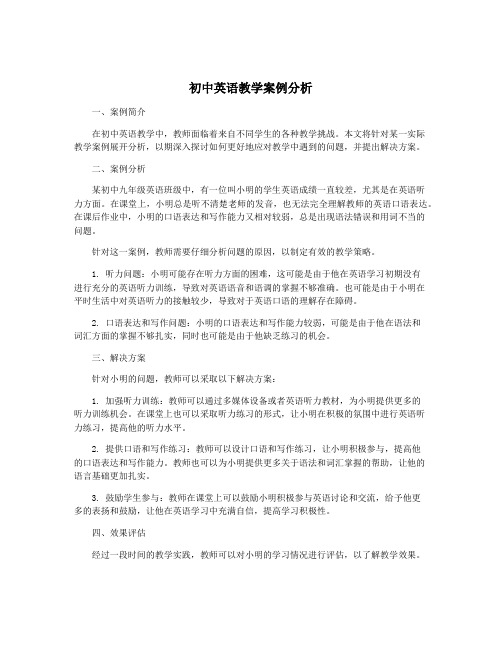
初中英语教学案例分析一、案例简介在初中英语教学中,教师面临着来自不同学生的各种教学挑战。
本文将针对某一实际教学案例展开分析,以期深入探讨如何更好地应对教学中遇到的问题,并提出解决方案。
二、案例分析某初中九年级英语班级中,有一位叫小明的学生英语成绩一直较差,尤其是在英语听力方面。
在课堂上,小明总是听不清楚老师的发音,也无法完全理解教师的英语口语表达。
在课后作业中,小明的口语表达和写作能力又相对较弱,总是出现语法错误和用词不当的问题。
针对这一案例,教师需要仔细分析问题的原因,以制定有效的教学策略。
1. 听力问题:小明可能存在听力方面的困难,这可能是由于他在英语学习初期没有进行充分的英语听力训练,导致对英语语音和语调的掌握不够准确。
也可能是由于小明在平时生活中对英语听力的接触较少,导致对于英语口语的理解存在障碍。
2. 口语表达和写作问题:小明的口语表达和写作能力较弱,可能是由于他在语法和词汇方面的掌握不够扎实,同时也可能是由于他缺乏练习的机会。
三、解决方案针对小明的问题,教师可以采取以下解决方案:1. 加强听力训练:教师可以通过多媒体设备或者英语听力教材,为小明提供更多的听力训练机会。
在课堂上也可以采取听力练习的形式,让小明在积极的氛围中进行英语听力练习,提高他的听力水平。
2. 提供口语和写作练习:教师可以设计口语和写作练习,让小明积极参与,提高他的口语表达和写作能力。
教师也可以为小明提供更多关于语法和词汇掌握的帮助,让他的语言基础更加扎实。
3. 鼓励学生参与:教师在课堂上可以鼓励小明积极参与英语讨论和交流,给予他更多的表扬和鼓励,让他在英语学习中充满自信,提高学习积极性。
四、效果评估经过一段时间的教学实践,教师可以对小明的学习情况进行评估,以了解教学效果。
1. 听力提高:通过观察小明的听力训练练习和课堂表现,教师可以判断小明的听力是否有所提高。
可以通过听力测试等形式来进行客观评估。
2. 口语表达和写作提高:通过小明的口语表达和写作练习,教师可以了解小明在口语和写作方面是否有所改善。
人教新目标九年级英语Unit3优秀教学案例

3.情境创设:通过展示不同国家的饮食文化视频,激发学生对健康饮食的兴趣。
(二)讲授新知
1.词汇教学:教授与健康饮食相关的词汇,如"nutritious food"、"balanced diet"、"healthy lifestyle"等,并引导学生进行实际操作,运用所学词汇进行表达。
2.句型教学:通过目标句型"How do you keep healthy?"和"What kind of food do you like?"的学习和实践,提高学生的口语表达能力。
4.通过对文章中的观点进行讨论和思考,培养学生独立思考和判断的能力,提高他们的思维品质。
作为一名特级教师,我深知教学目标的重要性,只有明确了教学目标,才能有针对性地进行教学设计,确保教学的有效性和高效性。通过以上对知识与技能、过程与方法、情感态度与价值观的详细阐述,希望能够帮助学生全面掌握本节课的内容,提高他们的综合语言运用能力,培养他们健康的生活方式和积极的人生观。
2.学生能够理解并运用目标句型"How do you keep healthy?"和"What kind of food do you like?"进行询问和表达个人喜好。
3.学生能够通过阅读理解文章,获取关于不同国家饮食文化的信息,并能够进行简单的交流和讨论。
九年级英语教学案例4篇
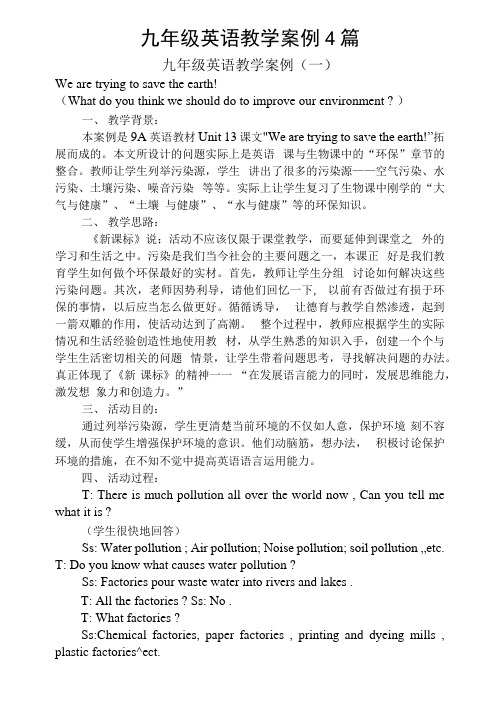
九年级英语教学案例4篇九年级英语教学案例(一)We are trying to save the earth!(What do you think we should do to improve our environment ? )一、教学背景:本案例是9A英语教材Unit 13课文"We are trying to save the earth!”拓展而成的。
本文所设计的问题实际上是英语课与生物课中的“环保”章节的整合。
教师让学生列举污染源,学生讲出了很多的污染源——空气污染、水污染、土壤污染、噪音污染等等。
实际上让学生复习了生物课中刚学的“大气与健康”、“土壤与健康”、“水与健康”等的环保知识。
二、教学思路:《新课标》说;活动不应该仅限于课堂教学,而要延伸到课堂之外的学习和生活之中。
污染是我们当今社会的主要问题之一,本课正好是我们教育学生如何做个环保最好的实材。
首先,教师让学生分组讨论如何解决这些污染问题。
其次,老师因势利导,请他们回忆一下, 以前有否做过有损于环保的事情,以后应当怎么做更好。
循循诱导,让德育与教学自然渗透,起到一箭双雕的作用,使活动达到了高潮。
整个过程中,教师应根据学生的实际情况和生活经验创造性地使用教材,从学生熟悉的知识入手,创建一个个与学生生活密切相关的问题情景,让学生带着问题思考,寻找解决问题的办法。
真正体现了《新课标》的精神一一“在发展语言能力的同时,发展思维能力,激发想象力和创造力。
”三、活动目的:通过列举污染源,学生更清楚当前环境的不仅如人意,保护环境刻不容缓,从而使学生增强保护环境的意识。
他们动脑筋,想办法,积极讨论保护环境的措施,在不知不觉中提高英语语言运用能力。
四、活动过程:T: There is much pollution all over the world now , Can you tell me what it is ?(学生很快地回答)Ss: Water pollution ; Air pollution; Noise pollution; soil pollution …etc. T: Do you know what causes water pollution ?Ss: Factories pour waste water into rivers and lakes .T: All the factories ? Ss: No .T: What factories ?Ss:Chemical factories, paper factories , printing and dyeing mills , plastic factories^ect.(在我们课本中有出现化工厂,因此学生首先想到的化工厂,在教学过程中很多学生不会用英语说而是用中文说一些没有学过的词,如:印染厂及塑料厂,塑料厂等。
初中英语九年级教育案例(2篇)
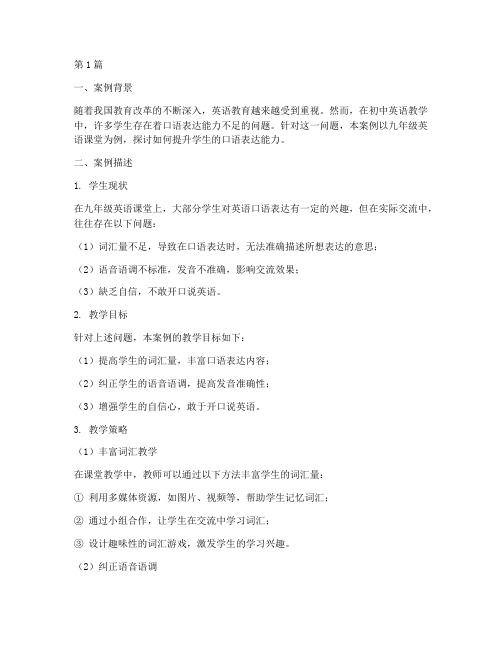
第1篇一、案例背景随着我国教育改革的不断深入,英语教育越来越受到重视。
然而,在初中英语教学中,许多学生存在着口语表达能力不足的问题。
针对这一问题,本案例以九年级英语课堂为例,探讨如何提升学生的口语表达能力。
二、案例描述1. 学生现状在九年级英语课堂上,大部分学生对英语口语表达有一定的兴趣,但在实际交流中,往往存在以下问题:(1)词汇量不足,导致在口语表达时,无法准确描述所想表达的意思;(2)语音语调不标准,发音不准确,影响交流效果;(3)缺乏自信,不敢开口说英语。
2. 教学目标针对上述问题,本案例的教学目标如下:(1)提高学生的词汇量,丰富口语表达内容;(2)纠正学生的语音语调,提高发音准确性;(3)增强学生的自信心,敢于开口说英语。
3. 教学策略(1)丰富词汇教学在课堂教学中,教师可以通过以下方法丰富学生的词汇量:① 利用多媒体资源,如图片、视频等,帮助学生记忆词汇;② 通过小组合作,让学生在交流中学习词汇;③ 设计趣味性的词汇游戏,激发学生的学习兴趣。
(2)纠正语音语调① 教师可以邀请英语发音标准的学生进行示范,让学生跟读、模仿;② 利用录音设备,让学生录制自己的发音,与标准发音进行对比,找出不足之处;③ 邀请外教或口语老师进行针对性指导。
(3)增强自信心① 鼓励学生在课堂上大胆开口,不怕犯错;② 组织英语角、英语演讲等活动,为学生提供展示自我的平台;③ 表扬学生的进步,增强学生的自信心。
4. 教学实施(1)课前准备教师根据教学内容,收集相关词汇、图片、视频等资料,制作课件;邀请外教或口语老师参与教学。
(2)课堂实施① 导入新课,激发学生学习兴趣;② 利用多媒体资源,丰富词汇教学;③ 学生进行小组合作,练习口语表达;④ 教师纠正学生的语音语调,指导发音;⑤ 学生进行角色扮演,提高口语表达能力;⑥ 组织英语角、英语演讲等活动,展示学生成果。
(3)课后总结教师总结本节课的学习成果,布置课后作业,巩固所学知识。
- 1、下载文档前请自行甄别文档内容的完整性,平台不提供额外的编辑、内容补充、找答案等附加服务。
- 2、"仅部分预览"的文档,不可在线预览部分如存在完整性等问题,可反馈申请退款(可完整预览的文档不适用该条件!)。
- 3、如文档侵犯您的权益,请联系客服反馈,我们会尽快为您处理(人工客服工作时间:9:00-18:30)。
初三英语教学案例分析Analysis of the Materials1. Status and FunctionIn this unit, students learn to talk about how to study. Such topic is very useful to students. It’s helpful to raise learning interest of all the students. Either more or less advanced students will benefit a lot.2.Analysis of the StudentsJunior students are teenagers . They face the great changes of physiology and psychology. As the difficulties of learning English raising, they really don’t know how to face the challenge of learning English well.I think this unit helps them a lot.Teaching design教学目标语言目标1. How do you study for test?Well, I study by working with my classmates.2. Have you ever studied with a group?Yes, I have. I’ve learned a lot that way.能力目标1.Train students’listening skill.2.Train students’communicative competence.3.To develop the ability of reading ,self-study , cooperation and communication .4.To enable the students to gain information from others.跨学科学习Art :1. Draw a picture about new vocabulary we learned.2. Appreciate the songs and films.语言结构Verb + by with gerund语言功能认识学习方法,克服学习困难。
学习策略与思维技巧通过听、说、唱、讨论、采访等多种教学方式体验学习英语乐趣。
重点词汇1)vocabulary 2)flashcard 3)aloud 4)pronunciation 5)pronounce 6)memorize 7)grammar8)differently 9)frustrating 10)frustrate 11)quickly 12) not at all 13)excited 14)end up 15)specific任务型活动How do you study for a test?Task One Task Two Task ThreeTalk with their classmatesText listening comprehension Interview their classmatesTeaching proceduresTask One : Talk with their classmatesstepsTeacher’s ActivitiesStudents’ActivitiesWhysDo warming- up activity.Ask the student on duty to answer what date is it today?And the final exam is coming, how do they prepare for their text.Talk with their classmate how do they study for their test? And find out their own way to study on the textbook.Get the Ss to learn the new words unwittingly, and raise their curiosity .Step 2Present some key wordsLearn the new wordsPave the way for later learningPlay the Speech Cassette unit 1 1b.Show exercises to the SsDo some listening comprehension exercises.Develop the Ss’listening and comprehensive competence .Step 4Make an example for them,And ask they to talk with their partner, and fulfill the bland.Talk with their group and finish the blank. And try to report to the class.Develop the Ss’speaking competence and how to learn from others.课堂实录(As a lead–in , the teacher greets the students for the first time .)T: Who’s on duty today ?S:(Stand up) I am .T: what is the date today?S: It’Dec the 9 .T: Oh, Next month is Spring Festival, do you feel happy?. (All the Ss feel exited)T: But before Spring Festival, you must take part in sth at school, guess? What’s that?S: It’s the final test.T: How do you study for a test? But, don’t worry , today we will learn how to study for a test.(After warming-up activity , presenting all the important words , the teacher plays the Speech Cassette 1a and shows some multiply choice exercises with some slides )Look at the textbook, then choose how do these three students study for a test?_a____1.Mei __c__2.Pierre __b__3.Antonioab cT: so how do you study for a test? Now please ask yourself and fill in the blank“T”or “F”on the textbook.T: Explain the language point by showing them some pictures.book书√flashcard 抽认卡×end up 告终√quickly 快地√by making flashcards by making vocabulary lists by listening to the tapes / cassettesT:let’sum up the way to study for a test?T: Now, please ask your classmates how do they study for a test? And do the report for us.for example. How do you study for a test.S: I study for a test by listening to music.T:Then you can write down, and do the report to us, She study for a test by listening to musicHow to study for a test ?Task Two : Text listening comprehensionstepsTeacher’s ActivitiesStudents’ActivitiesWhysStep 1Lead in by asking a question.Ask them to listen,show them the listening samples and give the correct answers.Do the listening and give the correct answer.Improving students listening ability.Step 2Ask students to show their answers.Tell the whole class his answer. .课堂实录T: Have you studied with a group?Ss:yes.T: let’s listen to the tape, what happen to this group? Then choose the right answer.(After listening)T: Now, let’s check the answer, No two, yes or no?T: Do you feel the listening easy, now let me make it difficult. For example, question 1 match dWhat about others? Question 2,3,4 match a,c,or d ,just listen carefully.(listen again and match)T: Have you finished?T: question two match a ,c or d?(then finish)QuestionsAnswers1.____Do you learn English watching English-language videos? ________2.____Do you ever practice conversations with friends? ________3.____ What about listening to tapes? ________4.____ What about listening to tapes? ________5._____Have you ever studied with a group? ________a.Yes,I have. I’ve learned a lot that way.b.Oh,yes. It improves my speaking skills.c.I do that sometimes. I think it helps.d.No. It’s too hard to understand the voices.Task Three : Make an interview and compete in groups stepsTeacher’s ActivitiesStudents’ActivitiesWhysStep 1Show a form before an interviewOffer Ss an article to read .Fulfill the form by reading, .Prepare for the interviewStep 2Watch and listen .Interview each other in pairs and fill in the form.Advocate studying throughpractice, cooperation ,and communication.Step 3Ask four groups choose their best pair for the competition . The best pair in each group competes before the whole class . Encourage students to have more learning motivation .Step4Consolidation :Present the vocabulary exercises.Finish the exercises .Learn from known to unknown.Enlarge the vocabulary.Step5Assign homeworkRequired: to fullfil 4 pair workOptional : Collect the opinions others and write a composition Make full use of all kinds of education resources to study .课堂实录Situation : After learning this 3a , we know the ways of learning English of three students. Now suppose you are a reporter of CCTV, you want to report Wei Ming, or liuchang, then do the report for us.A: I’m doing a survey about learning English. Can I ask you some questions?B: Sure.A: Great! What’s your name?A: Wei ming.B: And how do you study English?A: I study English by┄T: you have done a good job, So can we learn English in a happy way? Sure we can.Now, let enjoy the English-language videos.Warming –up activityPresenting key wordsTalk with classmates (Task 1)To fullfill do the listening comprehension Talk with your partners listening comprehension (Task 2 )listening to the tape listen again check the answerMake an interview ( Task 3)Reading Fill in the form Make a competition Consolidation:VocabularyRequired & Optional教学反思本课教材教育学生如何运用正确的学习方法进行学习,培养适合自己的学习策略,让学生能够学会反思自己学习的效果。
